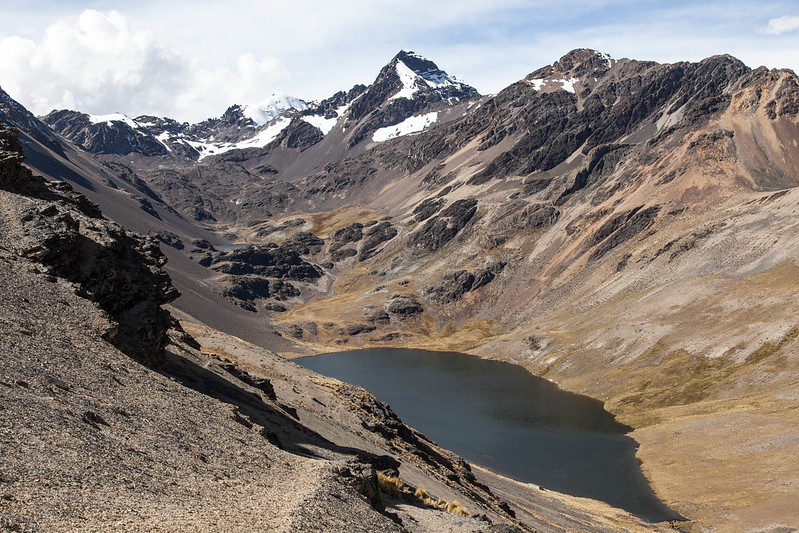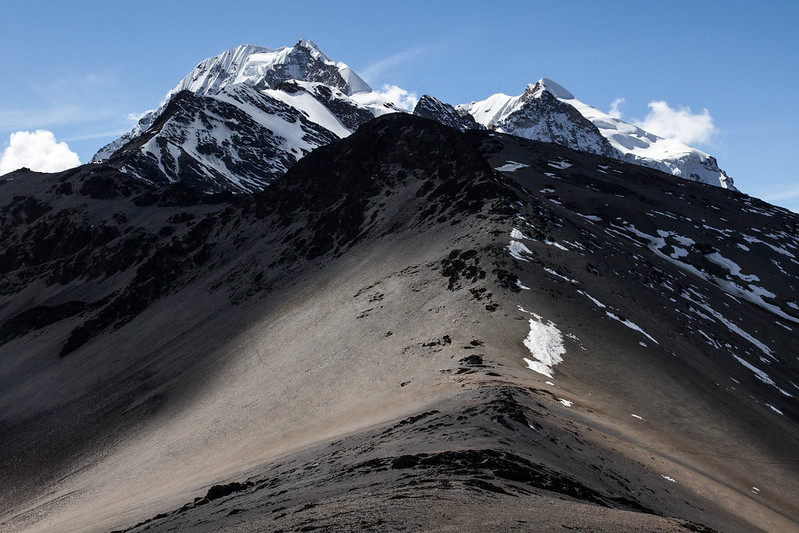 |
| Condoriri Base Camp at Ch'igara Quta |
As one of the most easily accessed ranges in the Andes, it would have been rude to pass by La Paz and not to incorporate a trek or a peak in the Cordillera Real. As it happened we managed to include both and all in the course of less than a week!
Having already attempted four summits in the Andes and only succeeded on two (largely due to the weather), our original plan for the Cordillera Real was to shun summits and head to the northern end of the range for a circular eight day trek known as the “Illampu Circuit”.
A three day jeep tour of the Salar de Uyuni (the giant salt flat in southern Bolivia) introduced us to Jenny and Tim, another “mad for it” couple from London, who were up for an adventure and keen to summit their first 6000er.
Susan and I were already well acclimatised after summiting San Miguel de Palermo (6000m) in the Nevado de Cachi range (northern Argentina) and a couple of volcanos in the Atacama. Jenny and Tim, however, needed a bit more time above 4000m to complete their acclimatisation. A drunken night at the Salt Hotel (you’ve heard of the Ice Hotel?, same idea!) and the plan was hatched. We’d do a five day trek followed by a three day ascent of what The Lonely Planet describes as “one of the easiest 6000m mountains in the world”: Huyana Potosi (6088m).
Despite The Lonely Planet’s quip, at AD-, Susan and I felt that the route up Huyana Potosi was outside of our limited Alpine experience (despite having previously summited two 6000ers unguided). To help with the trip, we lined up logistical support for the trek from Eduardo Mamani from Bolivian Mountain Guides, as well as guides for the attempt on Huyana Potosi.
Ten days later and we rendezvous with Jenny and Tim in La Paz. Susan’s on her first bout of “Boliva Belly” and I’m on my second. We’re in no fit state to start hiking. Our health, combined with the fact that Jenny and Tim need to rent gear and Eduardo’s gear rental supplier is having “legal problems” means that we hastily re-arrange the trek to a four day trip whilst the ascent of Huyana Potosi shrinks to two days.
Access to the Cordillera Real from La Paz is from the south west: from one of the many valleys running perpendicular to the range. The plan for the trek is to hop from one valley to another camping next to the many lakes dotted around the area taking in one or two 5000m passes per day. To fit the trek into four days, we plan for Eduardo to drop us at Laguna Ajwañi. We will trek independently east along the range and arrive four days later at one of the numerous refugios that have been set up at the base of Nevado Huyana Potosi to take guided groups up the mountain. Eduardo and another guide will meet us at the refugio the next morning (Day 5) for the trip to high camp and on to the summit (Day 6).
We obtain a poorly printed local map (gridlines at 45 degrees to the paper edges and an unknown scale of about 1:100,000) whilst Eduardo explains the route and the overnight camps. Less than 24 hours later and we are bumping along a rough track in Eduardo’s Landcruiser with Tim in the front seat looking green, the latest victim of Bolivia food poisoning roulette.

We had started much later than planned as the “legal problems” faced by Eduardo’s Swiss gear-rental partner had caused considerable delay back in La Paz that morning. We ford a river and then pull off the track. Eduardo jumps out, wanders 50m and looks apprehensively at the hills. “First pass” he says and starts driving over scrub bushes towards what we had planned to be the first pass of the day. The ground steepens and we begin to wonder just how far he’ll drive us. Fortunately he stops just short of a 45 degree scree slope and we bundle out relieved to be finally starting the trek.
 |
| Setting Off |
The second pass over to Juri Quta (Quta means “lake” in the local Aymara language) required more effort but was still only about 250-300m of ascent. Still, this proved a strain for Tim’s fragile stomach and by the time we reached our camp by the lake we had a broken Tim on our hands. The rental tent from Eduardo proved large enough for 3-4 people so became the logical place to congregate for dinner.
 |
| Laguna Sistaña |
Heading north up the west side of Juri Quota, the path climbs up the lateral glacial moraine to reach a beautiful glacial lake at about 5000m. The backdrop to the lake is the fabulous Cerro Condoriri: a bergschrund-rimmed central pyramid with two satellite knife edge ridges forming the head and wings of the Condor. After a brief lunch we start the most technical part of the trek, a rock scramble up to the pass with short traverse across a 20m drop that was probably about a grade 3 scramble. Not so much fun with heavy packs, big boots and “Bolivia Belly”!
At the top of the pass, off to one side is a small subsidiary summit (Cerro Austria 5300). We leave bags at the pass under Guy’s watchful, sick eye and, liberated of weight, we speed to the top. The summit reveals stunning views of Condoriri, Alpamayo and further off to the east the imposing near-vertical west face our destination: Nevado Huyana Potosi.
Racing the sun, we descend to camp at Ch’igara Quota and in the twilight run into Eduardo’s nephew Pedro guiding an Australian couple on Pequeño Alpamayo. The next morning over breakfast we meet one of the Australians, sick and returning to camp having abandoned the climb after an alpine start and getting halfway up the glacier. We empathise as it turns out that she is also suffering from “Bolivia Belly” combined with a nasty cold. Fingers crossed our tummy problems sort themselves out before Huyana Potosi!
 |
| Approaching the pass above Ch'igara Quta. |
We have low expectations for the last day with it being a bit of a “filler” to get us to the refugio at the base of Huyana Potosi. Eduardo has already warned us about the prospect of walking a chunk of it on a road. As it turns out, the pass is as picturesque as any we’ve seen and we hardly touch the road as we contour round into the Rio Zongo valley reaching the Refugio in early afternoon.
 |
| The West Face of Huyana Potosi (as seen from the pass above Ch'igara Quta). |
It’s a short hike up to the upper Refugio built on rock at one side of the glacier at about 5200m. Ten years ago, this didn’t exist and neither did the other two built nearby. This just goes to show the power of Lonely Planet. This is borne out by talking to the other ascentionists we meet there. Of the 20-30 Westerners staying with us, all of the teams are backpackers bar four visiting Spanish mountaineers. It’s obviously a highly commercial mountain for Eduardo who personally guides three teams a week to the top. All of this gives me shivers as I think about the very steep, exposed summit ridge and what it will probably mean to have to pass another group en-route. We spend the rest of the afternoon practising skills on the glacier (it’s new for Jenny and proves a good refresher for the rest of us).
 |
| Huayana Potosi from the final pass (south) on Day 4 |
Onto the glacier and we see the Spaniards (four on a rope) heading off as we fix crampons. With torches and the benefit of an almost full moon, we head off unroped following Eduardo with our other guide bringing up the rear. After an hour of soloing on 45 degree slopes, we reach the Bergschrund. I whisper to a nervous Susan: “You might have to ask for a rope rather than expect to be given one”. Eduardo must have been reading my mind as he breaks out the ropes (one per guided pair). The last snow was two weeks ago which has given plenty of time for the snow to form into nice névé and for an established path and steps to be cut. Never-the-less, we are all climbing to make it over with front points and picks in operation. Not so easy huffing and puffing at 5600m!
 |
| The south summit of Huayana Potosi as seen from the north summit (with Illumani in the background) |
Where we are at the tiny north summit is slightly higher than the south but is seriously corniced and Eduardo warns us back from the edge. There is probably space for 4-5 people and that’s about it. We take some photos and prepare to descend. “You first” he points to me. Surely not! “Um, someone else prefer to do it?” I mumble. Egged on, I start the descent conscious of every foot step and that any trip will send myself, Susan and our guide straight down the slope. We make it down without incident to the foot of the slope by which time the sun is well and truly up. We de-layer and gulp water and chocolate. Phew, we made the difficult bit!
Descending is a breeze and we are back at the hut by mid morning eating soup and packing our sleeping bags for the final bit of descent. By mid afternoon we are sitting in fumes in La Paz traffic dying to get to our hostel and retrieve our bags. Like Paddington Bear after his journey from “Darkest Peru”, we can’t decide whether to drink beer or shower first. To Guy’s disappointment, showers win out but it’s cheers all round as we hit the next-door bar and watch the final five minutes of world cup football.
 |
| La Paz and Illimani |

No comments:
Post a Comment